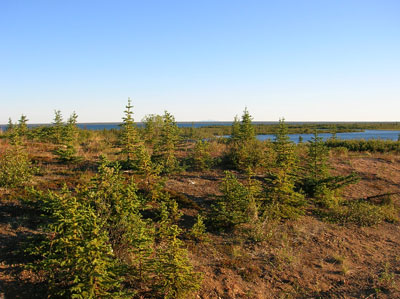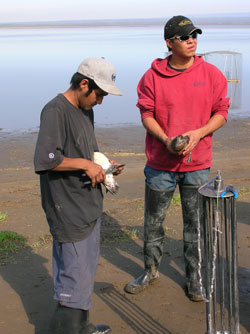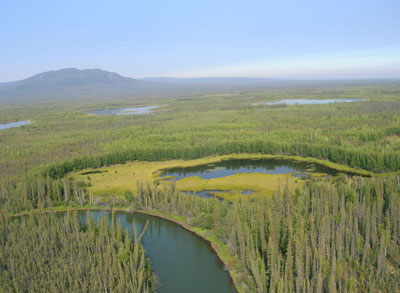 |
Only have a few minutes to write from where we are now in Norman Wells. There was an incredible migration yesterday morning in Deline. Hundreds of birds, mostly songbirds, passing overhead. Flocks of Savannah Sparrows and Lincoln's Sparrows as well as a few Yellow Warblers and Yellow-rumped Warblers. A single Orange-crowned Warbler landed on a telephone wire near where I was watching near the lake. Several flocks of Red-necked Phalaropes on Great Bear Lake along with some Bonaparte's Gulls and a fierce, heavy Pomarine Jaeger powering south. An American Golden Plover called plaintively as it passed over and made me think of what it would have been like to see an Eskimo Curlew migrating through as they undoubtedly did at one time here.
Flew out to Tulita on a scheduled Northways Air flight at mid-morning, then hopped aboard a helicopter that had us out to Willow Lake around noon. This is the location of an 11-year duck banding project that has banded thousands of Mallards, Northern Pintails, and other waterfowl. Band returns have come from throughout the U.S. and into northern Mexico. Willow Lake (called Bracket Lake on most maps) is a shallow lake that has been known as a major post-breeding and migratory concentration point for waterfowl for who-knows how long. It's even an officially recognized Important Bird Area! The Tulita people have had camps on the lake for waterfowl hunting for generations. The waterfowl banding camp has a log helipad and a small metal grain storage shed to store equipment and keep bears from the food. An electric fence surrounds the camp to keep curious bears away from camp--apparently black bears will come in and will even tear into plastic gas cans, styrofoam, and tires let alone foodstuffs. John Bidwell, a U.S. Fish and Wildlife service biologist from Maine, is leading the crew here. He has been coming out for about five years and spends a month here every August. Jonathan and Denver, two young men from Tulita, are here on a two-week shift as well. The crew takes us out to a location on the muddy shore--the lake is at the lowest level that Jonathan has seen in his lifetime--where large wire pens site in the shallow water. The pens have groups of American Wigeon and a few Blue-winged Teal flapping around within them. The birds come in to feed on the barley that the team spreads here and are caught.
 |
As John and the team demonstrates the banding and aging of the ducks, I take a look with my scope. Far across the lake is a small group of Sandhill Cranes, their calls echo through the amazingly quiet air. On the acres of muddy flats I spot ten Least Sandpipers, six Pectoral Sandpipers, two Sanderlings, and an American Golden Plover. There are acres and acres more of flats and shallows too far to scan and wonder what might be out there.
Later in the afternoon we are back on the helicopter for a flight to Norman Wells. Over and over we keep saying how big this place is. It's mind-blowing when you see it from the air. On the way over we see a black bear plunging across a stream and hundreds of ducks and geese.
Jeff Wells
More to come.
 |

